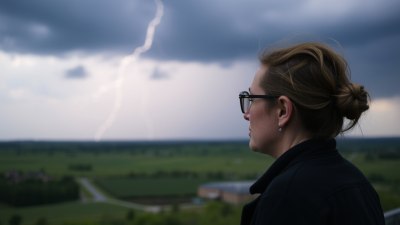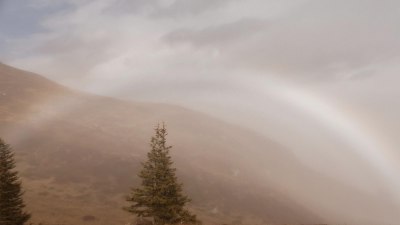Why We Avoid Eye Contact When It’s About to Storm
Explore the psychological and cultural reasons behind avoiding eye contact before a storm approaches.

Eye contact is a powerful aspect of human communication that conveys emotions, intentions, and social cues. But intriguingly, many people report an instinctive tendency to avoid eye contact when a storm is imminent. This behavior, though subtle and subconscious, has deep roots in psychology, biology, and culture, merging our responses to environmental cues with ancient survival mechanisms. Understanding why we avoid eye contact as storms approach offers insights into human nature and how we interact with both each other and the natural world.
The Role of Eye Contact in Human Communication
Before exploring why we avoid eye contact when the weather turns stormy, it is important to grasp the fundamental role eye contact plays in communication. In face-to-face interactions, eye contact helps regulate turn-taking in conversation, signals attention and interest, and transmits emotions such as trust, affection, or threat. Studies show that direct eye contact activates brain regions responsible for social cognition, making it a cornerstone of human connection. Without it, interactions can feel distant, evasive, or disconnected.
Eye contact also functions as a social signal that helps establish dominance or submission within groups. Strong, unwavering eye gaze can assert confidence and control, whereas avoiding eye contact may signal deference, anxiety, or fear. These social dynamics have evolutionary origins, as maintaining or avoiding gaze can prevent conflicts and foster cohesion among social animals. Therefore, the way humans use eye contact serves both communication and survival purposes.
Psychological Responses to Environmental Threats
Storms are natural events often associated with danger—strong winds, lightning, flooding, and unpredictable conditions. When a storm is about to strike, the environment subtly shifts, and our brains begin to prepare for potential threats. This preparation activates the body's stress response system, triggering increased heart rate, heightened senses, and changes in attention.
One key factor is the activation of the amygdala, the brain's center for processing fear and detecting threats. As storm clouds gather, looming darkness envelopes the sky, and thunder rumbles, the amygdala prompts vigilance. Many people become more inward-focused, scanning their surroundings for safety rather than engaging socially. Eye contact, which normally helps connect individuals, becomes less important and sometimes counterproductive, as it may evoke tension or arousal that detracts from survival-focused attention.
In this heightened state, avoiding direct gaze helps reduce cognitive load. Maintaining eye contact requires emotional and attentional resources, which can clash with the urgency of responding to environmental stressors. By unconsciously lowering gaze and minimizing social interaction, individuals can better allocate focus to anticipating the storm and seeking shelter or preparation.
Evolutionary Perspectives on Eye Contact and Storms
From an evolutionary standpoint, humans developed in environments where storms posed serious threats, including injury, loss of resources, and death. Our ancestors learned to recognize atmospheric signs—such as darkening skies, changes in wind, and drops in temperature—as warnings of impending danger. These natural cues triggered survival behaviors that increased chances of escaping harm.
Visual focus plays a critical part in these survival mechanisms. Avoiding eye contact may be linked to a broader tendency to reduce social engagement in moments requiring rapid self-preservation. Maintaining eye contact involves locking attention on another individual’s eyes, potentially signaling challenge or readiness for conflict. Before a storm, such social confrontations are costly distractions, so lowering gaze reduces the likelihood of misunderstandings or confrontations that may compromise safety.
Furthermore, some researchers suggest that the avoidance of eye contact during threatening environmental conditions could be a form of submissive behavior evolved to maintain group cohesion and minimize conflict in perilous situations. When everyone in a group instinctively lowers gaze, it may help signal peaceful intentions, defuse tension, and allow cooperative responses to the external threat of the storm.
Cultural Variations and Symbolism of Eye Contact and Storms
Culture also influences how eye contact is perceived and enacted during storms. In some cultures, direct eye contact is considered rude or aggressive under normal circumstances. During storms, these norms may amplify tendencies to avoid gaze, as the environment already induces caution and anxiety.
In traditional folklore from various regions, storms symbolize powerful forces of nature or divine judgment. For example, in many indigenous cultures, storms are seen as manifestations of angered spirits or gods. In such contexts, avoiding direct eye contact is a gesture of respect and humility toward these forces. People avert their gaze not only from each other but from the environment itself, acknowledging the sacred or fearsome nature of the storm.
Some Asian cultures emphasize modesty and emotional restraint, particularly in public. In these societies, avoiding eye contact during stressful events like storms aligns with cultural expectations to maintain social harmony and not exacerbate tension. Conversely, Western cultures typically encourage more direct eye contact, but even there, the unconscious avoidance before storms reveals a deep-seated human instinct transcending cultural boundaries.
Neurological Mechanisms Behind Eye Contact Avoidance
The brain’s response to storms involves multiple neural pathways that modulate attention and social behavior. Visual processing centers in the occipital cortex interpret changes in light and movement, signaling the approach of adverse weather. These sensory inputs feed into limbic structures like the amygdala and hypothalamus, which orchestrate emotional and autonomic responses such as fear and stress.
Simultaneously, the prefrontal cortex—which governs executive functions and social decision-making—evaluates the social environment. When prioritizing survival, this region may suppress behaviors associated with social engagement, such as making or sustaining eye contact. The resultant behavioral pattern is a conscious or subconscious gaze aversion, freeing cognitive resources for environmental assessment and preparatory actions.
Additionally, the autonomic nervous system’s “fight, flight, or freeze” responses influence eye contact. During the “freeze” response—a momentary pause to assess danger—individuals often look away to avoid detection or reduce stimulation. When a storm approaches, such freezing moments may manifest as lowered gaze or looking downward, reinforcing the avoidance of eye contact.
Psychosocial Factors and Group Dynamics
Humans are inherently social creatures, and their reactions to storms are influenced by the presence of others. Group dynamics alter how eye contact behaviors manifest under environmental stress.
In a group setting, people may avoid eye contact to prevent panic or tension. Eye contact can escalate emotions; a frightened gaze may cause others to mirror anxiety, whereas avoidance might help maintain calmness by not reinforcing stress through nonverbal cues. Leaders or figures of authority might deliberately reduce eye contact to signal control and discourage chaos, while others may follow suit subconsciously.
Moreover, in tight-knit communities, shared knowledge about storms contributes to coordinated behaviors. Collective avoidance of eye contact during dangerous weather may facilitate silent communication and mutual understanding without verbal distraction. This subtle social choreography supports efficient decision-making, such as organizing shelter or securing property.
Impact on Modern Behavior and Contemporary Experiences
In modern urban environments, the instinct to avoid eye contact before storms persists despite technological advances and safer infrastructure. People still sense the atmospheric changes and, even unconsciously, divert gaze. This suggests a primal survival mechanism embedded in the human psyche and maintained across centuries.
Modern social norms also shape this behavior. In densely populated areas, major storms prompt collective concern and stress. Eye contact avoidance functions as a social self-regulation strategy, managing personal anxiety while maintaining public composure. Smartphone usage increases during bad weather, further reducing direct eye contact among individuals, which compounds the natural tendency during storms.
On the other hand, certain professional roles, such as emergency responders or meteorologists, might override this instinct as they engage more directly with others to provide information and reassurance. For the general population, however, this behavioral inclination remains strong and observable.
Clinical and Psychological Implications
Understanding why people avoid eye contact during storms may have clinical relevance. For individuals with anxiety disorders or trauma linked to environmental events, the avoidance of gaze may intensify or reflect heightened stress. Therapists and counselors can use this knowledge to help patients become more aware of their nonverbal responses and develop coping strategies.
In social anxiety or post-traumatic stress disorder (PTSD), environmental triggers like storms can provoke amplified avoidance behaviors, including gaze aversion. Recognizing the role of storm-related stimuli in eye contact avoidance can inform treatment plans and therapeutic interventions, improving patient outcomes.
Furthermore, public safety messaging during extreme weather events might consider the psychological effects of storm-induced stress and natural avoidance behaviors to enhance communication strategies and community engagement.
Scientific Studies and Observations
While direct scientific research specifically on eye contact avoidance before storms is limited, related studies on environmental stress and social behavior offer valuable insights. Experiments examining human reactions to natural disasters, extreme weather events, and perceived threats demonstrate changes in gaze patterns, social interactions, and attention focus.
Eye-tracking technology reveals that individuals exposed to stressors often reduce eye contact and shift gaze downward or sideways. These patterns align with anecdotal descriptions of behavior before storms, suggesting an underlying neurobehavioral mechanism. Cross-cultural research also supports that gaze behaviors in adverse conditions follow universal principles modulated by learned norms.
Continued interdisciplinary studies combining psychology, neuroscience, anthropology, and meteorology could deepen understanding of these phenomena and their implications for human behavior and safety.
Practical Tips for Managing Eye Contact and Stress During Storms
Being aware of the natural tendency to avoid eye contact when a storm approaches can help individuals manage stress and social interactions more effectively. Here are some practical suggestions:
Recognize the instinct: Understanding that gaze aversion is a typical stress response can reduce self-judgment and discomfort.
Communicate clearly: When interacting with others during storms, use verbal communication to supplement reduced eye contact.
Practice grounding techniques: Focus on breathing and sensory awareness to stay calm and counteract anxiety-induced gaze avoidance.
Encourage supportive environments: Foster settings where people feel safe expressing emotions without fear of judgment, reducing the need for extreme gaze avoidance.
Future Research Directions
Understanding the nuances of eye contact avoidance related to environmental threats invites further investigation. Potential research directions include:
Longitudinal studies tracking eye contact behaviors across different weather conditions and cultural groups.
Neuroimaging research to map brain activity linked to gaze behaviors during storm anticipation.
Field studies incorporating eye-tracking during real or simulated storm events.
Investigations into how technology and urbanization influence natural preparedness behaviors.
Developing interventions that use knowledge of gaze patterns to improve mental health during environmental crises.
Such multidisciplinary work promises to enhance our understanding of human-environment interactions and improve resilience to natural threats.
In summary, avoiding eye contact when it’s about to storm represents a complex interplay of biological, psychological, social, and cultural factors. Rooted in ancient survival strategies and shaped by societal norms, this subtle behavior reveals much about how humans navigate both social worlds and the unpredictable natural environment. Recognizing and appreciating this tendency enriches our awareness of nonverbal communication and deepens our connection to shared human experience.











